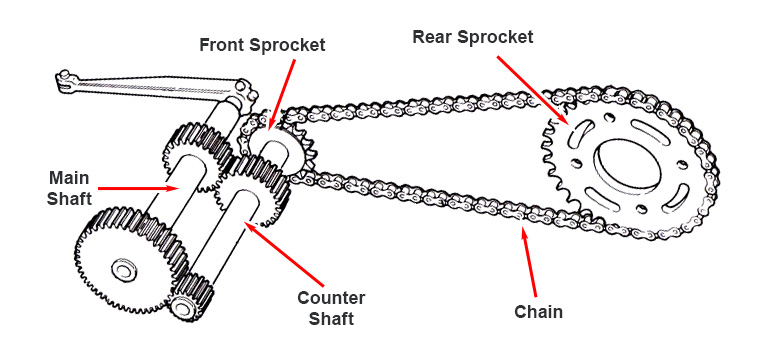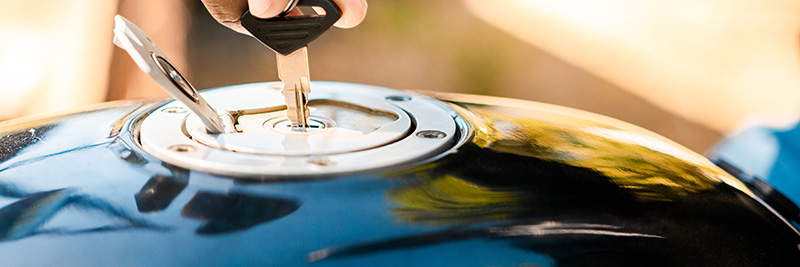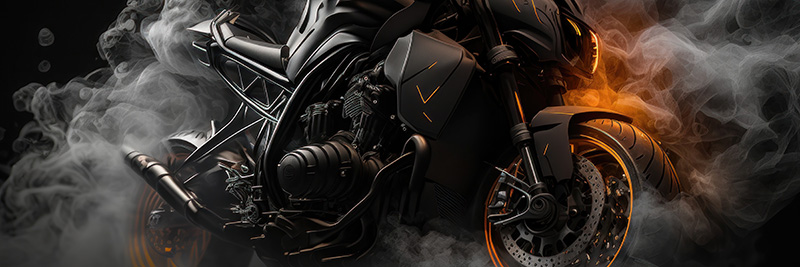Your motorcycle chain is one of the most vital, yet often overlooked components in your bike. Responsible for the transmission of power from the engine to the rear wheel, its simplicity belies its functionality.
Ever ridden a bike that’s suffered a catastrophic chain failure? Its one of the leading causes of motorcycle accidents in the US and while there is no data to support this in Australia, The Department of Transport and Main Roads Queensland recently published statistics showing that fatalities caused by motorcycle accidents are on the rise, in fact this year shows a 45% increase on the last 4 year average at the time of writing.
If you don’t want to be one of these statistics, it might pay to know a little more about this critical component in your motorcycle.
How Does My Motorcycle Chain Actually Work?
Almost all motorcycles operate using rear-wheel drive, which simply means the rear wheel is responsible for delivering power to the road. This is done using a rear sprocket, driven by the motion of your chain, which is in turn pulled by the front sprocket. This is all powered by your engine, which delivers power through the gearbox to that front sprocket.
The entire drivetrain is actually a pretty complex system, made up of numerous components with the chain being one of the most critical parts in this system.
The chain itself consists of a series of interlocking metal links connected to form a continuous loop. Each link in the chain comprises a pin, a bushing, and two side plates. These pins are held in place by the bushings and rotate within the side plates.
As the front sprocket rotates, the teeth of the sprocket mesh with the links in the chain, causing the chain to move and in turn, moves the rear sprocket and connected wheel.
What’s the Difference Between a Good Chain and a Bad One?
When it comes to differentiating a good motorcycle chain from a bad one, it’s not always a battle between good and bad. It’s more like a trade-off between performance, efficiency and cost.
Depending on the amount of riding you do, you’ll likely be replacing your chain anywhere between every few months to every couple of years so cost plays a role.
So another perspective might be useful - What do you want your chain to do for you? Are you looking for better fuel efficiency? Perhaps you need raw power, or maybe just low cost & longevity?
As you might have guessed, there is no one chain that does it all perfectly, so we’ve broken it down to address the benefits first so you can make up your own mind on the types, brands and features of various chains that suit you best.
The Chains Impact on Fuel efficiency
WEIGHT
The weight of the chain can impact fuel efficiency. A heavier chain can increase rotating mass, which requires more power to accelerate and maintain speed, resulting in increased fuel consumption. A lighter chain can reduce rotating mass and improve fuel efficiency.
FRICTION
Friction between the chain and sprockets can also affect fuel efficiency. A poorly lubricated or dirty chain can cause increased friction, resulting in power losses and increased fuel consumption. A sealed chain, such as an O-ring or X-ring chain, can reduce friction and require less maintenance than a non-sealed chain.
CONDITION
The condition of the chain can also impact fuel efficiency. A worn or damaged chain can increase friction and cause power losses, resulting in increased fuel consumption. Regular chain maintenance, including cleaning, lubricating, and inspecting for wear and damage, can help ensure optimal fuel efficiency.
TENSION
The tension of the chain can also impact fuel efficiency. An over-tightened chain can cause excessive wear and friction, resulting in power losses and increased fuel consumption. A loose chain can also reduce power transfer and increase friction, resulting in decreased fuel efficiency.
How Your chain Affects Torque & Power
TENSION
The motorcycle chain needs to be properly tensioned to transfer power efficiently. An over-tightened chain can cause excessive wear and increase resistance, resulting in power losses. A loose chain can also reduce power transfer and cause the chain to skip or even fall off the sprockets.
STRETCH
Over time, the chain can stretch and increase in length, which can reduce power transfer and cause the chain to skip or even fall off the sprockets. Regular maintenance and proper tensioning can help prevent chain stretch and ensure efficient power transfer.
QUALITY
The quality of the chain can also impact power and torque transfer. A high-quality chain with precise manufacturing and materials can reduce friction and resist wear, resulting in better power transfer and improved performance.
WEIGHT
The weight of the chain can also impact performance. A lighter chain can reduce rotating mass and improve acceleration, while a heavier chain can increase rotating mass and reduce acceleration.
IS your Chain Safe?
STRENGTH
The strength of the chain is an important consideration when it comes to safety. A chain that is too weak for the motorcycle's engine output can break or fail, causing a loss of power and potentially dangerous situations. It's important to choose a chain with a high enough strength rating for the motorcycle's power output.
CONDITION
A worn or damaged chain can also be a safety hazard. A chain that is stretched, rusted, or has damaged links can fail unexpectedly, causing the chain to break or come off the sprockets while riding. Regular chain maintenance, including cleaning, lubricating, and inspecting for wear and damage, can help ensure safe operation.
TYPE
The type of chain used can also affect safety. A high-quality, sealed chain, such as an O-ring or X-ring chain, can reduce the risk of chain failure and require less maintenance than a non-sealed chain. Additionally, a chain that is properly tensioned and adjusted can reduce the risk of the chain coming off the sprockets while riding.
SPROCKETS
The condition of the sprockets that the chain rides on can also affect safety. Worn or damaged sprockets can cause the chain to wear more quickly and may cause the chain to come off the sprockets while riding. Regular sprocket maintenance and replacement can help ensure safe operation.
Different Types of Motorcycle Chain
Standard (Non-sealed) Chains for Affordability
When it comes to motorcycle chains, the standard or non-sealed chains might not sound as fancy as the X-ring or O-ring chains, but don't let that fool you. They have a lot of unique values that make them a popular choice for many riders.
One of the main benefits of standard chains is that they're often more affordable than other types of chains. Let's face it, motorcycles are expensive enough as it is, so saving a few bucks on a chain can be a big deal. Plus, if you're not racing or putting your bike through extreme conditions, a standard chain might be all you need to keep your bike rolling.
Another advantage of standard chains is that they're often easier to install and maintain. Unlike sealed chains that require specialised tools and lubricants, standard chains can be easily adjusted and lubricated with everyday tools and products. This means less time in the garage and more time on the road, which is always a good thing.
Standard chains are also suitable for a wide range of motorcycles, from small dirt bikes to large touring bikes. They're versatile and can handle most riding conditions, making them a great choice for riders who use their bikes for commuting, touring, or just having fun on the weekends.
Of course, standard chains do have their drawbacks. They don't offer the same level of sealing and lubrication as sealed chains, which means they can wear out faster and require more maintenance. But for riders who are willing to put in a little extra effort, a standard chain can still be a great choice.
So, the next time you're in the market for a new chain, give the standard chain a chance. Who knows, you might be pleasantly surprised by how well it performs and how much money it saves you. And who doesn't love saving money?
O-Ring Chains For Power
If you're a motorcycle enthusiast, you've probably heard of O-ring chains. These types of chains are popular among riders because they offer several unique advantages that make them stand out from other chain types.
O-ring chains are designed to reduce friction and increase durability. They feature rubber O-rings between the links that create a seal, preventing dirt, dust, and other debris from getting inside the chain. This means the chain requires less maintenance and lasts longer than other chain types.
O-ring chains are often used on heavier motorcycles that demand more power, such as cruisers and touring bikes. These types of bikes need chains that can handle high torque and power without wearing out too quickly. O-ring chains are built to withstand the rigors of heavy-duty riding, making them a popular choice for these types of motorcycles.
Another benefit of O-ring chains is that they're designed to reduce noise. If you've ever ridden a motorcycle with a noisy chain, you know how annoying it can be. O-ring chains dampen vibration and noise, providing a smoother and quieter ride.
In addition to their durability and noise reduction, O-ring chains also offer better performance. The rubber O-rings provide a better seal, reducing friction and allowing the chain to transfer power more efficiently. This means your motorcycle can accelerate faster and reach higher speeds with less effort.
Of course, O-ring chains do come with a higher price tag than other chain types. However, many riders believe the benefits of reduced maintenance and longer lifespan are worth the extra cost.
X-Ring Chains for Performance
X-ring motorcycle chains are a special type of chain that many riders are choosing over traditional chains. They're designed to offer superior performance and durability
and last longer than other chains, making them a great choice for riders who want to get the most out of their motorcycle.
One of the cool things about x-ring chains is that they're sealed tighter than other chains. This keeps dirt and debris out of the chain, which helps it last longer and perform better. They also distribute lubricant more evenly, which reduces wear and tear on the chain and means less maintenance for the rider.
Another great thing about x-ring chains is that they're really strong. They can handle a lot of stress and strain, which is important for high-performance motorcycles. They can also handle heavy loads, which is great for touring bikes and adventure bikes.
Overall, x-ring chains are a great choice for riders who want a chain that can handle anything they throw at it. They're suitable for all types of motorcycles and can improve performance, durability, and maintenance requirements. However, they can be more expensive than other chains and may require special tools or techniques to install properly.
The bottom line is that if you want the best for your motorcycle, an x-ring chain might be the way to go. They're built to last and can make a big difference in how your bike performs on the road.
Heavy-Duty Chains for Tough Conditions
If you're an adventure rider, you know the importance of a sturdy and reliable motorcycle chain. Heavy Duty (HD) chains are the go-to choice for riders who tackle rough terrain and demand the most from their bikes.
HD chains are built to withstand the rigors of off-road riding and are designed for high-performance motorcycles or those with high power output.. They're thicker and stronger than other chain types, with hardened pins and bushings that can handle high torque and power. This means they're less likely to break or stretch, providing a more reliable ride in challenging conditions.
One of the unique advantages of HD chains is their ability to handle heavy loads. Adventure bikes often carry extra gear and luggage, which puts more stress on the chain. HD chains are designed to handle the added weight without wearing out too quickly.
HD chains are also ideal for riders who frequently ride in wet or muddy conditions. The thicker links and bushings create a more durable barrier against debris, reducing the risk of chain failure due to mud and dirt buildup.
When it comes to maintenance, HD chains require more attention than other chain types. However, they're worth the extra effort if you want a chain that can handle rough terrain and heavy loads. Regular cleaning and lubrication will keep your HD chain in top condition and ensure a longer lifespan.
HD chains are used on a variety of motorcycles, from adventure bikes to dirt bikes and motocross machines. They're also popular among street riders who demand the most from their bikes. If you're a rider who wants a chain that can handle anything you throw at it, an HD chain might be the perfect choice for you.
In terms of cost, HD chains are generally more expensive than other chain types. However, the added durability and reliability are worth the investment for adventure riders who demand the most from their bikes.
In conclusion, Heavy Duty chains are the go-to choice for adventure riders who demand the most from their motorcycles. They offer increased strength, durability, and reliability in rough terrain and heavy load conditions. While they require more maintenance than other chain types, the benefits of a longer lifespan and improved performance make them a popular choice among riders. If you're looking for a chain that can handle anything you throw at it, consider investing in an HD chain for your motorcycle.
are designed for high-performance motorcycles or those with high power output.
Lightweight Chains for Speed
For riders who prioritise speed and performance, lightweight chains are a game-changer. These chains are specifically designed to reduce weight without sacrificing strength or durability, making them the go-to choice for sportbike riders and racers.
Lightweight chains are made from high-quality materials that are both strong and lightweight, such as aluminium or titanium. This allows for a reduction in overall weight, which can result in increased speed and acceleration.
One of the unique advantages of lightweight chains is their ability to reduce drivetrain inertia. In simpler terms, the reduced weight of the chain means less rotational mass, which translates to quicker throttle response and improved handling.
Lightweight chains are also a popular choice for riders who demand the best in racing performance. The reduced weight can provide a significant advantage on the track, where every ounce matters. This advantage is particularly notable in motorsports where weight plays a critical role in performance, such as motocross and road racing.
When it comes to maintenance, lightweight chains require similar care to other chain types. However, they can be more sensitive to wear and tear, particularly in high-stress situations. Regular cleaning and lubrication are essential to maintaining a lightweight chain's performance and durability.






